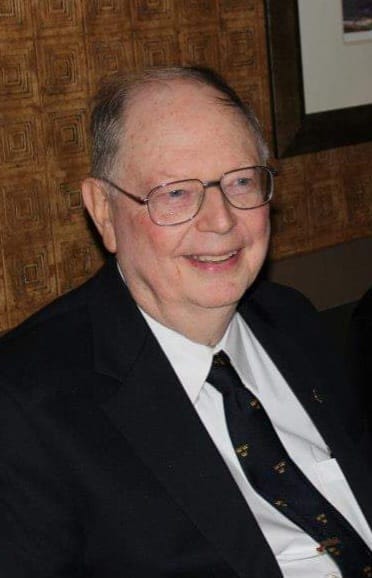In Loving Memory of Dale Nordin (NOVEMBER 17, 1937 – OCTOBER 25, 2023)

It is with heavy hearts that we announce the passing of one of our original choir members, Dale Nordin. He was a cherished member of our Vasa Drängar family. Dale departed this world on October 25, 2023, due to a tragic accident. He was 85 years old and had lived a long, vibrant life.
Dale’s presence in our choir and within our community was a source of inspiration and joy. His unwavering dedication to music and his warm, friendly spirit touched the hearts of everyone who had the privilege of knowing him.
While the circumstances of Dale’s passing were unexpected and deeply saddening, we remember him for the joy and camaraderie he brought to our choir. Our thoughts are with his beloved wife, Lilian Nordin, and the entire Nordin family during this challenging time.
Funeral arrangements for Dale Nordin will be forthcoming, and we will share this information as soon as it becomes available.
Dale’s memory will forever live on in the songs we sing, the music we create, and the friendships we cherish within Vasa Drängar. He leaves behind a legacy of music, camaraderie, and the indomitable spirit of our choir.
In this time of mourning, may we find solace in the beautiful music that Dale shared with us and in the knowledge that his memory will continue to resonate within our choir.
Please join us in honoring Dale Nordin’s memory and offering our support to Lilian and the Nordin family during this challenging time. We will always remember and celebrate the life of a beloved member, friend, and fellow musician.
With heartfelt condolences,
Vasa Drängar
— Update —
OBITUARY
Dale Peter Nordin
NOVEMBER 17, 1937 – OCTOBER 25, 2023

Dale Peter Nordin, age 85 passed away on Wednesday, October 25, 2023.
Born on November 17, 1937, in White Plains, NY to Ebba and Peter Nordin. His family moved to Ft. Lauderdale, FL when he was 9 years old. He enlisted in the US Air Force in 1960 and spent 4 years in the service, two of those in Spain.
He married his wife, Lilian, in 1967 and they were married for 56 years. In 1974, the family moved to Marietta, GA where Dale worked for Georgia Tech Research Institute for 24 years as an Electronics Specialist. That interest in electronics also continued throughout his life.
He was very proud of his linguistic ability, something he shared with his daughter, Desiree, and was still fluent in Swedish and Spanish at the time of his passing.
Dale was an avid ham radio operator and got his first license at the age of 15. With the call sign K4HGG, all the neighborhood knew of his giant radio tower in the backyard. He continued this passion by being involved in various radio clubs, HamFests, and the North Carolina morning and evening net.
Dale was a faithful member of Hope Presbyterian Church, where he served as deacon. He loved to sing, both as a member of his church choir and the local Swedish men’s choir, Vasa Drängar. Dale and Lilian were early members of the Vasa Order of America chapter in Atlanta & loved to folk dance. Dale volunteered as a Scoutmaster for the Boy Scouts of America and was incredibly proud when his son, Lars, earned his Eagle Scout rank.
Dale was preceded in death by his parents, Peter & Ebba Nordin.
He is survived by his loving wife, Lilian, of Acworth; son, Lars (Penny) Nordin of Woodstock; daughter, Desiree (Frank) Tuvell of Woodstock; and grandchildren, Nicole & Christoffer Tuvell, Lukas & Wyatt Nordin.
In lieu of flowers, the family requests donations may be made to Reformation Hope (www.reformationhope.org) 4101 Sandy Plains Rd, Marietta, Ga 30066, or Trans World Radio (www.twr.org) P.O. Box 8700, Cary, N.C. 27512-8700.
A visitation for Dale will be held Wednesday, November 1, 2023 from 4:00 PM to 7:00 PM at Woodstock Funeral Home, Inc., 8855 Main Street, Woodstock, GA 30188. A funeral service will occur Thursday, November 2, 2023 from 11:30 AM to 1:00 PM, 8855 Main Street, Woodstock, GA 30188. A committal service will occur Thursday, November 2, 2023 from 2:30 PM to 3:00 PM at Georgia National Cemetery, 1080 Scott Hudgens Dr, Canton, GA 30114.
Fond memories and expressions of sympathy may be shared at www.woodstockfuneralhome.com for the Nordin family.
In Loving Memory of Dale Nordin (NOVEMBER 17, 1937 – OCTOBER 25, 2023) Read More »
